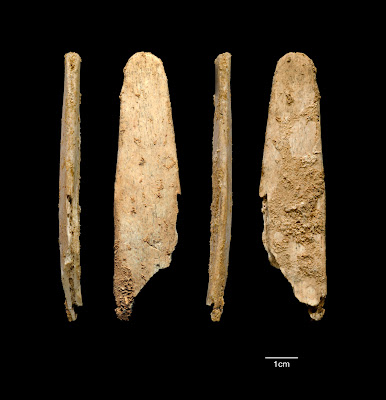The tool is called a lissoir, was made by Neandertals living in southwestern France long before the arrival of the people we like to call “anatomically modern humans.” The discovery, reported in the August 16, 2013 online issue of PNAS, is sure to fuel the debate over the cultural sophistication of the Neandertals.
Caption: Four views of the most complete lissoir found
during excavations at the Neandertal site of Abri Peyrony. Credit: Image courtesy of the Abri Peyrony and
Pech-de-l’Azé I Projects.
Ever since their discovery over 150 years ago, Neandertals have been seen as “cavemen,” primitive in every respect compared to us “modern” humans who replaced them.
But in recent decades, the cultural achievements of Neandertals have been recognized. Even so, the debate continues. Did they learn more advanced technology from the modern human invaders of Europe and Asia, or did they develop it on their own? The new findings lends support to the view that Neandertals were able to create and invent on their own.
Neandertals were very likely the first to use sophisticated bone tools in Europe. The tool found in France was made from the rib bone of red deer or possibly reindeer. Making it required breaking, grinding, and polishing. It shows evidence of being used to work leather, much like similar tools today. When rubbed against an animal hide, it makes the leather soft, shiny, and more water resistant.
"For now the bone tools from these two sites are one of the better pieces of evidence we have for Neandertals developing on their own a technology previously associated only with modern humans", explains Shannon McPherron of the Max Planck Institute for Evolutionary Anthropology in Leipzig according to a press release from the Institute.
Tools like this first appear in Africa much earlier. But this new finding raising intriguing questions. Did “modern” humans bring this technology from Africa and pass it to Neandertals prior to 50,000 years ago? Is there a technology transfer around the same time as modern/Neandertal interbreeding? Or did Neandertals invent this technology on their own and transfer it to the modern humans who began to arrive in Europe around 40,000 years ago?
"If Neandertals developed this type of bone tool on their own, it is possible that modern humans then acquired this technology from Neandertals. Modern humans seem to have entered Europe with pointed bone tools only, and soon after started to make lissoirs. This is the first possible evidence for transmission from Neandertals to our direct ancestors," says Marie Soressi of Leiden University in The Netherlands, part of the team of researchers who made this discovery.
"Lissoirs like these are a great tool for working leather, so much so that 50 thousand years after Neandertals made these, I was able to purchase a new one on the Internet from a site selling tools for traditional crafts," says Soressi. "It shows that this tool was so efficient that it had been maintained through time with almost no change. It might be one or perhaps even the only heritage from Neandertal times that our society is still using today."
Neandertals at this time were making sophisticated stone tools. But these tools were made of bone because bone can is more adaptable for certain uses. According to McPherron, "here we have an example of Neandertals taking advantage of the pliability and flexibility of bone to shape it in new ways to do things stone could not do."
The deeper question that lies behind this research is whether “modern humans” burst on the scene suddenly as a unique phenomenon of evolution, or whether the process of becoming human is more gradual and more widely distributed than we once thought.
The research reported here was conducted by teams from Max Planck Institute for Evolutionary Anthropology in Leipzig, Germany, and the University of Leiden in the Netherlands. The article, entitled “Neandertals made the first specialized bone tools in Europe,” appears in the August 16, 2013 online edition of the Proceedings of the National Academy of Sciences.
